12 Social Psychology

CHAPTER OUTLINE
12.1 What is Social Psychology?
12.2 Self-presentation
12.3 Attitudes and Persuasion
12.4 Conformity, Compliance, and Obedience
12.5 Prejudices and Discrimination
12.6 Aggression
12.7 Prosocial Behavior
INTRODUCTION: Social psychologists examine how the presence of others impacts how a person behaves and reacts, whether that person is an athlete playing a game, a police officer on the job, or a worshiper attending a religious service. Social psychologists believe that a person’s behavior is influenced by who else is present in a given situation and the composition of social groups.
12.1 What is Social Psychology?
LEARNING OBJECTIVES
By the end of this section, you will be able to:
- Define social psychology
- Describe situational versus dispositional influences on behavior
- Describe the fundamental attribution error
- Explain actor-observer bias
- Describe self-serving bias
- Explain the just-world hypothesis
Social psychology examines how people affect one another, and it looks at the power of the situation. According to the American Psychological Association (n.d.), social psychologists “are interested in all aspects of personality and social interaction, exploring the influence of interpersonal and group relationships on human behavior.” Throughout this chapter, we will examine how the presence of other individuals and groups of people impacts a person’s behaviors, thoughts, and feelings. Essentially, people will change their behavior to align with the social situation at hand. If we are in a new situation or are unsure how to behave, we will take our cues from other individuals.
The field of social psychology studies topics at both the intra- and interpersonal levels. Intrapersonal topics (those that pertain to the individual) include emotions and attitudes, the self, and social cognition (the ways in which we think about ourselves and others). Interpersonal topics (those that pertain to dyads and groups) include helping behavior (Figure 12.2), aggression, prejudice and discrimination, attraction and close relationships, and group processes and intergroup relationships.

Situational and Dispositional Influences on Behavior
Behavior is a product of both the situation (e.g., cultural influences, social roles, and the presence of bystanders) and of the person (e.g., personality characteristics). Subfields of psychology tend to focus on one influence or behavior over others. Situationism is the view that our behavior and actions are determined by our immediate environment and surroundings. In contrast, dispositionism holds that our behavior is determined by internal factors (Heider, 1958). An internal factor is an attribute of a person and includes personality traits and temperament. Social psychologists have tended to take the situationist perspective, whereas personality psychologists have promoted the dispositionist perspective. Modern approaches to social psychology, however, take both the situation and the individual into account when studying human behavior (Fiske, Gilbert, & Lindzey, 2010). In fact, the field of social-personality psychology has emerged to study the complex interaction of internal and situational factors that affect human behavior (Mischel, 1977; Richard, Bond, & Stokes-Zoota, 2003).
Fundamental Attribution Error
In the United States, the predominant culture tends to favor a dispositional approach in explaining human behavior. Why do you think this is? We tend to think that people are in control of their own behaviors, and, therefore, any behavior change must be due to something internal, such as their personality, habits, or temperament. According to some social psychologists, people tend to overemphasize internal factors as explanations—or attributions—for the behavior of other people. They tend to assume that the behavior of another person is a trait of that person, and to underestimate the power of the situation on the behavior of others. They tend to fail to recognize when the behavior of another is due to situational variables, and thus to the person’s state. This erroneous assumption is called the fundamental attribution error (Ross, 1977; Riggio & Garcia, 2009). To better understand, imagine this scenario: Jamie returns home from work, and opens the front door to a happy greeting from spouse Morgan who inquires how the day has been. Instead of returning the spouse’s kind greeting, Jamie yells, “Leave me alone!” Why did Jamie yell? How would someone committing the fundamental attribution error explain Jamie’s behavior? The most common response is that Jamie is a mean, angry, or unfriendly person (traits). This is an internal or dispositional explanation. However, imagine that Jamie was just laid off from work due to company downsizing. Would your explanation for Jamie’s behavior change? Your revised explanation might be that Jamie was frustrated and disappointed about being laid off and was therefore in a bad mood (state). This is now an external or situational explanation for Jamie’s behavior.
The fundamental attribution error is so powerful that people often overlook obvious situational influences on behavior. A classic example was demonstrated in a series of experiments known as the quizmaster study (Ross, Amabile, & Steinmetz, 1977). Student participants were randomly assigned to play the role of a questioner (the quizmaster) or a contestant in a quiz game. Questioners developed difficult questions to which they knew the answers, and they presented these questions to the contestants. The contestants answered the questions correctly only 4 out of 10 times (Figure 12.3). After the task, the questioners and contestants were asked to rate their own general knowledge compared to the average student. Questioners did not rate their general knowledge higher than the contestants, but the contestants rated the questioners’ intelligence higher than their own. In a second study, observers of the interaction also rated the questioner as having more general knowledge than the contestant. The obvious influence on performance is the situation. The questioners wrote the questions, so of course they had an advantage. Both the contestants and observers made an internal attribution for the performance. They concluded that the questioners must be more intelligent than the contestants.

As demonstrated in the examples above, the fundamental attribution error is considered a powerful influence in how we explain the behaviors of others. However, it should be noted that some researchers have suggested that the fundamental attribution error may not be as powerful as it is often portrayed. In fact, a recent review of more than 173 published studies suggests that several factors (e.g., high levels of idiosyncrasy of the character and how well hypothetical events are explained) play a role in determining just how influential the fundamental attribution error is (Malle, 2006).
Is the Fundamental Attribution Error a Universal Phenomenon?
You may be able to think of examples of the fundamental attribution error in your life. Do people in all cultures commit the fundamental attribution error? Research suggests that they do not. People from an individualistic culture, that is, a culture that focuses on individual achievement and autonomy, have the greatest tendency to commit the fundamental attribution error. Individualistic cultures, which tend to be found in western countries such as the United States, Canada, and the United Kingdom, promote a focus on the individual. Therefore, a person’s disposition is thought to be the primary explanation for her behavior. In contrast, people from a collectivistic culture, that is, a culture that focuses on communal relationships with others, such as family, friends, and community (Figure 12.4), are less likely to commit the fundamental attribution error (Markus & Kitayama, 1991; Triandis, 2001).

| Characteristics of Individualistic and Collectivistic Cultures | |
|---|---|
| Individualistic Culture | Collectivistic Culture |
| Achievement oriented | Relationship oriented |
| Focus on autonomy | Focus on group harmony |
| Dispositional perspective | Situational perspective |
| Independent | Interdependent |
| Analytic thinking style | Holistic thinking style |
Masuda and Nisbett (2001) demonstrated that the kinds of information that people attend to when viewing visual stimuli (e.g., an aquarium scene) can differ significantly depending on whether the observer comes from a collectivistic versus an individualistic culture. Japanese participants were much more likely to recognize objects that were presented when they occurred in the same context in which they were originally viewed. Manipulating the context in which object recall occurred had no such impact on American participants. Other researchers have shown similar differences across cultures. For example, Zhang, Fung, Stanley, Isaacowitz, and Zhang (2014) demonstrated differences in the ways that holistic thinking might develop between Chinese and American participants, and Ramesh and Gelfand (2010) demonstrated that job turnover rates are more related to the fit between a person and the organization in which they work in an Indian sample, but the fit between the person and their specific job was more predictive of turnover in an American sample.
Actor-Observer Bias
Returning to our earlier example, Jamie was laid off, but an observer would not know. So a naïve observer would tend to attribute Jamie’s hostile behavior to Jamie’s disposition rather than to the true, situational cause. Why do you think we underestimate the influence of the situation on the behaviors of others? One reason is that we often don’t have all the information we need to make a situational explanation for another person’s behavior. The only information we might have is what is observable. Due to this lack of information we have a tendency to assume the behavior is due to a dispositional, or internal, factor. When it comes to explaining our own behaviors, however, we have much more information available to us. If you came home from school or work angry and yelled at your dog or a loved one, what would your explanation be? You might say you were very tired or feeling unwell and needed quiet time—a situational explanation. The actor-observer bias is the phenomenon of attributing other people’s behavior to internal factors (fundamental attribution error) while attributing our own behavior to situational forces (Jones & Nisbett, 1971; Nisbett, Caputo, Legant, & Marecek, 1973; Choi & Nisbett, 1998). As actors of behavior, we have more information available to explain our own behavior. However as observers, we have less information available; therefore, we tend to default to a dispositionist perspective.
One study on the actor-observer bias investigated reasons male participants gave for why they liked their girlfriend (Nisbett et al., 1973). When asked why participants liked their own girlfriend, participants focused on internal, dispositional qualities of their girlfriends (for example, her pleasant personality). The participants’ explanations rarely included causes internal to themselves, such as dispositional traits (for example, “I need companionship.”). In contrast, when speculating why a male friend likes his girlfriend, participants were equally likely to give dispositional and external explanations. This supports the idea that actors tend to provide few internal explanations but many situational explanations for their own behavior. In contrast, observers tend to provide more dispositional explanations for a friend’s behavior (Figure 12.5).
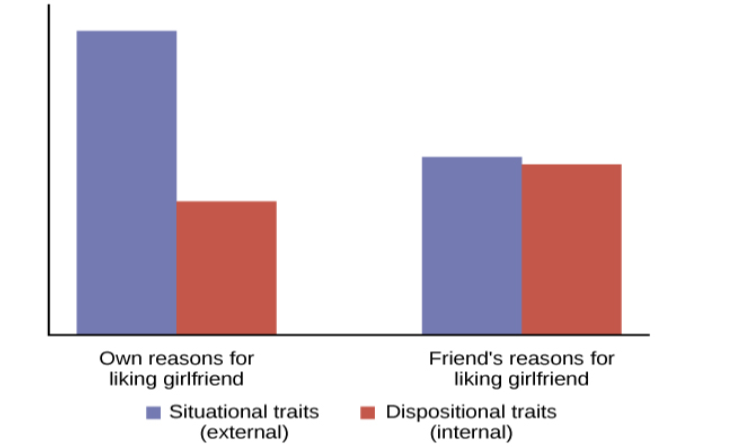
Self-Serving Bias
We can understand self-serving bias by digging more deeply into attribution, a belief about the cause of a result. One model of attribution proposes three main dimensions: locus of control (internal versus external), stability (stable versus unstable), and controllability (controllable versus uncontrollable). In this context, stability refers the extent to which the circumstances that result in a given outcome are changeable. The circumstances are considered stable if they are unlikely to change. Controllability refers to the extent to which the circumstances that are associated with a given outcome can be controlled. Obviously, those things that we have the power to control would be labeled controllable (Weiner, 1979).
Following an outcome, self-serving biases are those attributions that enable us to see ourselves in a favorable light (for example, making internal attributions for success and external attributions for failures). When you do well at a task, for example acing an exam, it is in your best interest to make a dispositional attribution for your behavior (“I’m smart,”) instead of a situational one (“The exam was easy,”). The tendency of an individual to take credit by making dispositional or internal attributions for positive outcomes (Miller & Ross, 1975). Self-serving bias is the tendency to explain our successes as due to dispositional (internal) characteristics, but to explain our failures as due to situational (external) factors. Again, this is culture dependent. This bias serves to protect self-esteem. You can imagine that if people always made situational attributions for their behavior, they would never be able to take credit and feel good about their accomplishments.
Consider the example of how we explain our favorite sports team’s wins. Research shows that we make internal, stable, and controllable attributions for our team’s victory (Figure 12.6) (Grove, Hanrahan, & McInman, 1991). For example, we might tell ourselves that our team is talented (internal), consistently works hard (stable), and uses effective strategies (controllable). In contrast, we are more likely to make external, unstable, and uncontrollable attributions when our favorite team loses. For example, we might tell ourselves that the other team has more experienced players or that the referees were unfair (external), the other team played at home (unstable), and the cold weather affected our team’s performance (uncontrollable).

Just-World Hypothesis
One consequence of westerners’ tendency to provide dispositional explanations for behavior is victim blame (Jost & Major, 2001). When people experience bad fortune, others tend to assume that they somehow are responsible for their own fate. A common ideology, or worldview, in the United States is the just-world hypothesis. The just-world hypothesis is the belief that people get the outcomes they deserve (Lerner & Miller, 1978). In order to maintain the belief that the world is a fair place, people tend to think that good people experience positive outcomes, and bad people experience negative outcomes (Jost, Banaji, & Nosek, 2004; Jost & Major, 2001). The ability to think of the world as a fair place, where people get what they deserve, allows us to feel that the world is predictable and that we have some control over our life outcomes (Jost et al., 2004; Jost & Major, 2001). For example, if you want to experience positive outcomes, you just need to work hard to get ahead in life.
Can you think of a negative consequence of the just-world hypothesis? One negative consequence is people’s tendency to blame poor individuals for their plight. What common explanations are given for why people live in poverty? Have you heard statements such as, “The poor are lazy and just don’t want to work” or “Poor people just want to live off the government”? What types of explanations are these, dispositional or situational? These dispositional explanations are clear examples of the fundamental attribution error. Blaming poor people for their poverty ignores situational factors that impact them, such as high unemployment rates, recession, poor educational opportunities, and the familial cycle of poverty (Figure 12.7). Other research shows that people who hold just-world beliefs have negative attitudes toward people who are unemployed and people living with AIDS (Sutton & Douglas, 2005). In the United States and other countries, victims of sexual assault may find themselves blamed for their abuse. Victim advocacy groups, such as Domestic Violence Ended (DOVE), attend court in support of victims to ensure that blame is directed at the perpetrators of sexual violence, not the victims.

12.1 TEST YOURSELF
12.2 Self-presentation
LEARNING OBJECTIVES
By the end of this section, you will be able to:
- Describe social roles and how they influence behavior
- Explain what social norms are and how they influence behavior
- Define script
- Describe the findings of Zimbardo’s Stanford prison experiment
As you’ve learned, social psychology is the study of how people affect one another’s thoughts, feelings, and behaviors. We have discussed situational perspectives and social psychology’s emphasis on the ways in which a person’s environment, including culture and other social influences, affect behavior. In this section, we examine situational forces that have a strong influence on human behavior including social roles, social norms, and scripts. We discuss how humans use the social environment as a source of information, or cues, on how to behave. Situational influences on our behavior have important consequences, such as whether we will help a stranger in an emergency or how we would behave in an unfamiliar environment.
Social Roles
One major social determinant of human behavior is our social roles. A social role is a pattern of behavior that is expected of a person in a given setting or group (Hare, 2003). Each one of us has several social roles. You may be, at the same time, a student, a parent, an aspiring teacher, a son or daughter, a spouse, and a lifeguard. How do these social roles influence your behavior? Social roles are defined by culturally shared knowledge. That is, nearly everyone in a given culture knows what behavior is expected of a person in a given role. For example, what is the social role for a student? If you look around a college classroom you will likely see students engaging in studious behavior, taking notes, listening to the professor, reading the textbook, and sitting quietly at their desks (Figure 12.8). Of course you may see students deviating from the expected studious behavior such as texting on their phones or using Facebook on their laptops, but in all cases, the students that you observe are attending class—a part of the social role of students.
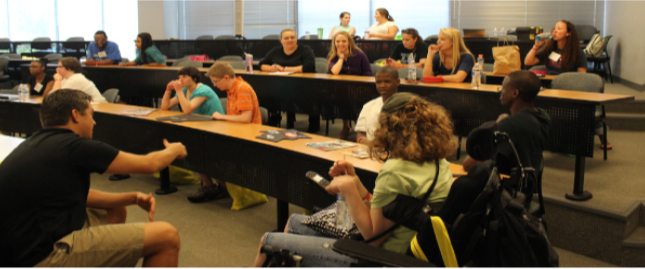
Social Norms
As discussed previously, social roles are defined by a culture’s shared knowledge of what is expected behavior of an individual in a specific role. This shared knowledge comes from social norms. A social norm is a group’s expectation of what is appropriate and acceptable behavior for its members—how they are supposed to behave and think (Deutsch & Gerard, 1955; Berkowitz, 2004). How are we expected to act? What are we expected to talk about? What are we expected to wear? In our discussion of social roles we noted that colleges have social norms for students’ behavior in the role of student and workplaces have social norms for employees’ behaviors in the role of employee. Social norms are everywhere including in families, gangs, and on social media outlets. What are some social norms on Facebook?
CONNECT THE CONCEPTS
Tweens, Teens, and Social Norms
My 11-year-old daughter, Janelle, recently told me she needed shorts and shirts for the summer, and that she wanted me to take her to a store at the mall that is popular with preteens and teens to buy them. I have noticed that many girls have clothes from that store, so I tried teasing her. I said, “All the shirts say ‘Aero’ on the front. If you are wearing a shirt like that and you have a substitute teacher, and the other girls are all wearing that type of shirt, won’t the substitute teacher think you are all named ‘Aero’?”
My daughter replied, in typical 11-year-old fashion, “Mom, you are not funny. Can we please go shopping?”
I tried a different tactic. I asked Janelle if having clothing from that particular store will make her popular. She replied, “No, it will not make me popular. It is what the popular kids wear. It will make me feel happier.” How can a label or name brand make someone feel happier? Think back to what you’ve learned about lifespan development. What is it about pre-teens and young teens that make them want to fit in (Figure 12.9)? Does this change over time? Think back to your high school experience, or look around your college campus. What is the main name brand clothing you see? What messages do we get from the media about how to fit in?

Scripts
Because of social roles, people tend to know what behavior is expected of them in specific, familiar settings. A script is a person’s knowledge about the sequence of events expected in a specific setting (Schank & Abelson, 1977). How do you act on the first day of school, when you walk into an elevator, or are at a restaurant? For example, at a restaurant in the United States, if we want the server’s attention, we try to make eye contact. In Brazil, you would make the sound “psst” to get the server’s attention. You can see the cultural differences in scripts. To an American, saying “psst” to a server might seem rude, yet to a Brazilian, trying to make eye contact might not seem an effective strategy. Scripts are important sources of information to guide behavior in given situations. Can you imagine being in an unfamiliar situation and not having a script for how to behave? This could be uncomfortable and confusing. How could you find out about social norms in an unfamiliar culture?
Zimbardo’s Stanford Prison Experiment
The famous Stanford prison experiment, conducted by social psychologist Philip Zimbardo and his colleagues at Stanford University, demonstrated the power of social roles, social norms, and scripts. In the summer of 1971, an advertisement was placed in a California newspaper asking for male volunteers to participate in a study about the psychological effects of prison life. More than 70 men volunteered, and these volunteers then underwent psychological testing to eliminate candidates who had underlying psychiatric issues, medical issues, or a history of crime or drug abuse. The pool of volunteers was whittled down to 24 healthy male college students. Each student was paid $15 per day (equivalent to about $80 today) and was randomly assigned to play the role of either a prisoner or a guard in the study. Based on what you have learned about research methods, why is it important that participants were randomly assigned?
A mock prison was constructed in the basement of the psychology building at Stanford. Participants assigned to play the role of prisoners were “arrested” at their homes by Palo Alto police officers, booked at a police station, and subsequently taken to the mock prison. The experiment was scheduled to run for several weeks. To the surprise of the researchers, both the “prisoners” and “guards” assumed their roles with zeal. On the second day of the experiment, the guards forced the prisoners to strip, took their beds, and isolated the ringleaders using solitary confinement. In a relatively short time, the guards came to harass the prisoners in an increasingly sadistic manner, through a complete lack of privacy, lack of basic comforts such as mattresses to sleep on, and through degrading chores and late-night counts.
The prisoners, in turn, began to show signs of severe anxiety and hopelessness—they began tolerating the guards’ abuse. Even the Stanford professor who designed the study and was the head researcher, Philip Zimbardo, found himself acting as if the prison was real and his role, as prison supervisor, was real as well. After only six days, the experiment had to be ended due to the participants’ deteriorating behavior. Zimbardo explained,
At this point it became clear that we had to end the study. We had created an overwhelmingly powerful situation—a situation in which prisoners were withdrawing and behaving in pathological ways, and in which some of the guards were behaving sadistically. Even the “good” guards felt helpless to intervene, and none of the guards quit while the study was in progress. Indeed, it should be noted that no guard ever came late for his shift, called in sick, left early, or demanded extra pay for overtime work. (Zimbardo, 2013)
The Stanford Prison Experiment has been used as a memorable demonstration of the incredible power that social roles, norms, and scripts have in affecting human behavior. However, multiple aspects of the study have been subject to criticism since its inception. The nature of these criticisms range from ethical concerns to issues of generalizability (Bartels, Milovich, & Moussier, 2016; Griggs, 2014; Le Texier, 2019). One criticism is that the way students were recruited for the experiment may have impacted the outcome (Carnahan & McFarland, 2007). Another criticism questions the conclusions that can be drawn from the study. Zimbardo appears to have provided specific guidelines of the types of behaviors that were expected of the guards (Zimbardo, 2007). Subsequent research suggests that such guidelines likely created an expectation of the types of behavior that Zimbardo reported observing in the Stanford Prison Experiment (Bartels, 2019), and that given these expectations, the guards simply acted as they thought they were expected to act. It has also been problematic that attempts to replicate aspects of the study have not been successful. For example, when no guidelines were presented to the guards, researchers documented different outcomes than those observed by Zimbardo. (Reicher & Haslam, 2006). The Stanford Prison Experiment has some parallels with the abuse of prisoners of war by U.S. Army troops and CIA personnel at the Abu Ghraib prison in 2003 and 2004 during the Iraq War. The offenses at Abu Ghraib were documented by photographs of the abuse, some taken by the abusers themselves (Figure 12.10).

12.2 TEST YOURSELF
12.3 Attitudes and Persuasion
LEARNING OBJECTIVES
By the end of this section, you will be able to:
- Define attitude
- Describe how people’s attitudes are internally changed through cognitive dissonance
- Explain how people’s attitudes are externally changed through persuasion
- Describe the peripheral and central routes to persuasion
Social psychologists have documented how the power of the situation can influence our behaviors. Now we turn to how the power of the situation can influence our attitudes and beliefs. Attitude is our evaluation of a person, an idea, or an object. We have attitudes for many things ranging from products that we might pick up in the supermarket to people around the world to political policies. Typically, attitudes are favorable or unfavorable: positive or negative (Eagly & Chaiken, 1993). And, they have three components: an affective component (feelings), a behavioral component (the effect of the attitude on behavior), and a cognitive component (belief and knowledge) (Rosenberg & Hovland, 1960).
For example, you may hold a positive attitude toward recycling. This attitude should result in positive feelings toward recycling (such as “It makes me feel good to recycle” or “I enjoy knowing that I make a small difference in reducing the amount of waste that ends up in landfills”). Certainly, this attitude should be reflected in our behavior: You actually recycle as often as you can. Finally, this attitude will be reflected in favorable thoughts (for example, “Recycling is good for the environment” or “Recycling is the responsible thing to do”).
Our attitudes and beliefs are not only influenced by external forces, but also by internal influences that we control. Like our behavior, our attitudes and thoughts are not always changed by situational pressures, but they can be consciously changed by our own free will. In this section we discuss the conditions under which we would want to change our own attitudes and beliefs.
What is Cognitive Dissonance?
Social psychologists have documented that feeling good about ourselves and maintaining positive self-esteem is a powerful motivator of human behavior (Tavris & Aronson, 2008). In the United States, members of the predominant culture typically think very highly of themselves and view themselves as good people who are above average on many desirable traits (Ehrlinger, Gilovich, & Ross, 2005). Often, our behavior, attitudes, and beliefs are affected when we experience a threat to our self-esteem or positive self-image. Psychologist Leon Festinger (1957) defined cognitive dissonance as psychological discomfort arising from holding two or more inconsistent attitudes, behaviors, or cognitions (thoughts, beliefs, or opinions). Festinger’s theory of cognitive dissonance states that when we experience a conflict in our behaviors, attitudes, or beliefs that runs counter to our positive self-perceptions, we experience psychological discomfort (dissonance). For example, if you believe smoking is bad for your health but you continue to smoke, you experience conflict between your belief and behavior (Figure 12.11).
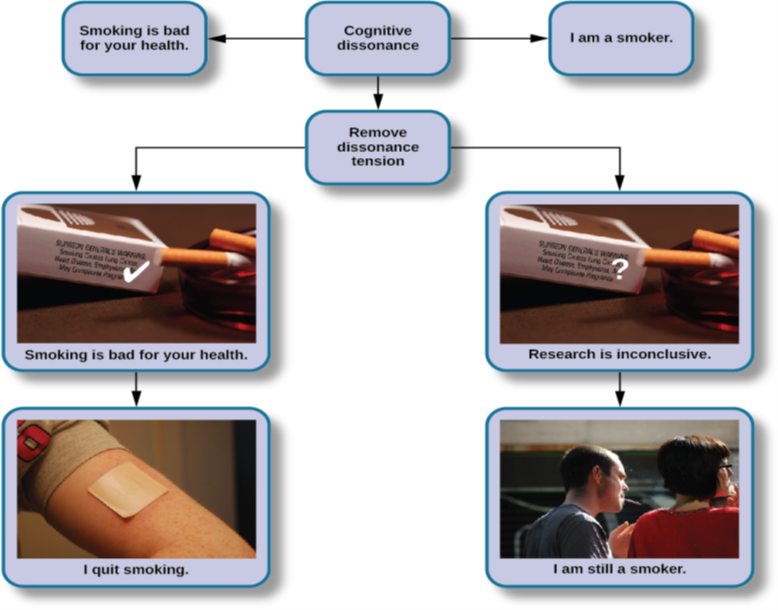
- changing our discrepant behavior (e.g., stop smoking),
- changing our cognitions through rationalization or denial (e.g., telling ourselves that health risks can be reduced by smoking filtered cigarettes),
- adding a new cognition (e.g., “Smoking suppresses my appetite so I don’t become overweight, which is good for my health.”).
A classic example of cognitive dissonance is Joaquin, a 20-year-old who enlists in the military. During boot camp he is awakened at 5:00 a.m., is chronically sleep deprived, yelled at, covered in sand flea bites, physically bruised and battered, and mentally exhausted (Figure 12.12). It gets worse. Recruits that make it to week 11 of boot camp have to do 54 hours of continuous training.

If Joaquin keeps thinking about how miserable he is, it is going to be a very long four years. He will be in a constant state of cognitive dissonance. As an alternative to this misery, Joaquin can change his beliefs or attitudes. He can tell himself, “I am becoming stronger, healthier, and sharper. I am learning discipline and how to defend myself and my country. What I am doing is really important.” If this is his belief, he will realize that he is becoming stronger through his challenges. He then will feel better and not experience cognitive dissonance, which is an uncomfortable state.
The Effect of Initiation
The military example demonstrates the observation that a difficult initiation into a group influences us to like the group more. Another social psychology concept, justification of effort, suggests that we value goals and achievements that we put a lot of effort into. According to this theory, if something is difficult for us to achieve, we believe it is more worthwhile. For example, if you move to an apartment and spend hours assembling a dresser you bought from Ikea, you will value that more than a fancier dresser your parents bought you. We do not want to have wasted time and effort to join a group that we eventually leave. A classic experiment by Aronson and Mills (1959) demonstrated this justification of effort effect. College students volunteered to join a campus group that would meet regularly to discuss the psychology of sex. Participants were randomly assigned to one of three conditions: no initiation, an easy initiation, and a difficult initiation into the group. After participating in the first discussion, which was deliberately made very boring, participants rated how much they liked the group. Participants who underwent a difficult initiation process to join the group rated the group more favorably than did participants with an easy initiation or no initiation (Figure 12.13).
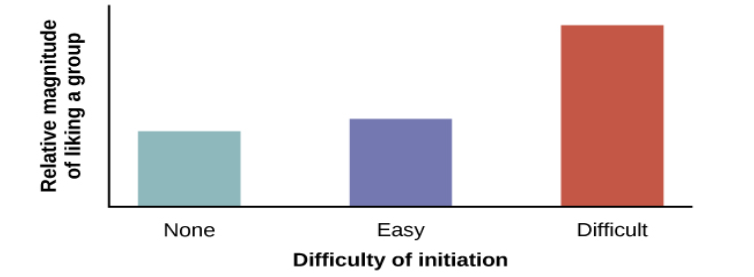
Besides the classic military example and group initiation, can you think of other examples of cognitive dissonance? Here is one: Maria and Marco live in Fairfield County, Connecticut, which is one of the wealthiest areas in the United States and has a very high cost of living. Maria telecommutes from home and Marco does not work outside of the home. They rent a very small house for more than $3000 a month. Marco shops at consignment stores for clothes and economizes when possible. They complain that they never have any money and that they cannot buy anything new. When asked why they do not move to a less expensive location, since Maria telecommutes, they respond that Fairfield County is beautiful, they love the beaches, and they feel comfortable there. How does the theory of cognitive dissonance apply to Maria and Marco’s choices?
Persuasion
In the previous section, we discussed that the motivation to reduce cognitive dissonance leads us to change our attitudes, behaviors, and/or cognitions to make them consonant. Persuasion is the process of changing our attitude toward something based on some kind of communication. Much of the persuasion we experience comes from outside forces. How do people convince others to change their attitudes, beliefs, and behaviors (Figure 12.14)? What communications do you receive that attempt to persuade you to change your attitudes, beliefs, and behaviors?

Yale Attitude Change Approach
The topic of persuasion has been one of the most extensively researched areas in social psychology (Fiske et al., 2010). During the Second World War, Carl Hovland extensively researched persuasion for the U.S. Army. After the war, Hovland continued his exploration of persuasion at Yale University. Out of this work came a model called the Yale attitude change approach, which describes the conditions under which people tend to change their attitudes. Hovland demonstrated that certain features of the source of a persuasive message, the content of the message, and the characteristics of the audience will influence the persuasiveness of a message (Hovland, Janis, & Kelley, 1953).
Features of the source of the persuasive message include the credibility of the speaker (Hovland & Weiss, 1951) and the physical attractiveness of the speaker (Eagly & Chaiken, 1975; Petty, Wegener, & Fabrigar, 1997). Thus, speakers who are credible, or have expertise on the topic, and who are deemed as trustworthy are more persuasive than less credible speakers. Similarly, more attractive speakers are more persuasive than less attractive speakers. The use of famous actors and athletes to advertise products on television and in print relies on this principle. The immediate and long term impact of the persuasion also depends, however, on the credibility of the messenger (Kumkale & Albarracín, 2004).
Features of the message itself that affect persuasion include subtlety (the quality of being important, but not obvious) (Petty & Cacioppo, 1986; Walster & Festinger, 1962); sidedness (that is, having more than one side) (Crowley & Hoyer, 1994; Igou & Bless, 2003; Lumsdaine & Janis, 1953); timing (Haugtvedt & Wegener, 1994; Miller & Campbell, 1959), and whether both sides are presented. Messages that are more subtle are more persuasive than direct messages. Arguments that occur first, such as in a debate, are more influential if messages are given back-to-back. However, if there is a delay after the first message, and before the audience needs to make a decision, the last message presented will tend to be more persuasive (Miller & Campbell, 1959).
Features of the audience that affect persuasion are attention (Albarracín & Wyer, 2001; Festinger & Maccoby, 1964), intelligence, self-esteem (Rhodes & Wood, 1992), and age (Krosnick & Alwin, 1989). In order to be persuaded, audience members must be paying attention. People with lower intelligence are more easily persuaded than people with higher intelligence; whereas people with moderate self-esteem are more easily persuaded than people with higher or lower self-esteem (Rhodes & Wood, 1992). Finally, younger adults aged 18–25 are more persuadable than older adults.
Elaboration Likelihood Model
An especially popular model that describes the dynamics of persuasion is the elaboration likelihood model of persuasion (Petty & Cacioppo, 1986). The elaboration likelihood model considers the variables of the attitude change approach—that is, features of the source of the persuasive message, contents of the message, and characteristics of the audience are used to determine when attitude change will occur. According to the elaboration likelihood model of persuasion, there are two main routes that play a role in delivering a persuasive message: central and peripheral (Figure 12.15).

The central route to persuasion works best when the target of persuasion, or the audience, is analytical and willing to engage in processing of the information. From an advertiser’s perspective, what products would be best sold using the central route to persuasion? What audience would most likely be influenced to buy the product? One example is buying a computer. It is likely, for example, that small business owners might be especially influenced by the focus on the computer’s quality and features such as processing speed and memory capacity.
The peripheral route is an indirect route that uses peripheral cues to associate positivity with the message (Petty & Cacioppo, 1986). Instead of focusing on the facts and a product’s quality, the peripheral route relies on association with positive characteristics such as positive emotions and celebrity endorsement. For example, having a popular athlete advertise athletic shoes is a common method used to encourage young adults to purchase the shoes. This route to attitude change does not require much effort or information processing. This method of persuasion may promote positivity toward the message or product, but it typically results in less permanent attitude or behavior change. The audience does not need to be analytical or motivated to process the message. In fact, a peripheral route to persuasion may not even be noticed by the audience, for example in the strategy of product placement. Product placement refers to putting a product with a clear brand name or brand identity in a TV show or movie to promote the product (Gupta & Lord, 1998). For example, one season of the reality series American Idol prominently showed the panel of judges drinking out of cups that displayed the Coca-Cola logo. What other products would be best sold using the peripheral route to persuasion? Another example is clothing: A retailer may focus on celebrities that are wearing the same style of clothing.
Foot-in-the-door Technique
Researchers have tested many persuasion strategies that are effective in selling products and changing people’s attitude, ideas, and behaviors. One effective strategy is the foot-in-the-door technique (Cialdini, 2001; Pliner, Hart, Kohl, & Saari, 1974). Using the foot-in-the-door technique, the persuader gets a person to agree to bestow a small favor or to buy a small item, only to later request a larger favor or purchase of a bigger item. The foot-in-the-door technique was demonstrated in a study by Freedman and Fraser (1966) in which participants who agreed to post small sign in their yard or sign a petition were more likely to agree to put a large sign in their yard than people who declined the first request (Figure 12.16). Research on this technique also illustrates the principle of consistency (Cialdini, 2001): Our past behavior often directs our future behavior, and we have a desire to maintain consistency once we have a committed to a behavior.

How would a store owner use the foot-in-the-door technique to sell you an expensive product? For example, say that you are buying the latest model smartphone, and the salesperson suggests you purchase the best data plan. You agree to this. The salesperson then suggests a bigger purchase—the three-year extended warranty. After agreeing to the smaller request, you are more likely to also agree to the larger request. You may have encountered this if you have bought a car. When salespeople realize that a buyer intends to purchase a certain model, they might try to get the customer to pay for many or most available options on the car. Another example of the foot-in-the-door technique would be applied to an individual in the market for a used car who decides to buy a fully loaded new car. Why? Because the salesperson convinced the buyer that they need a car that has all of the safety features that were not available in the used car.
12.3 TEST YOURSELF
12.4 Conformity, Compliance, and Obedience
LEARNING OBJECTIVES
By the end of this section, you will be able to:
- Explain the Asch effect
- Define conformity and types of social influence
- Describe Stanley Milgram’s experiment and its implications
- Define groupthink, social facilitation, and social loafing
In this section, we discuss additional ways in which people influence others. The topics of conformity, social influence, obedience, and group processes demonstrate the power of the social situation to change our thoughts, feelings, and behaviors. We begin this section with a discussion of a famous social psychology experiment that demonstrated how susceptible humans are to outside social pressures.
Conformity
Solomon Asch conducted several experiments in the 1950s to determine how people are affected by the thoughts and behaviors of other people. In one study, a group of participants was shown a series of printed line segments of different lengths: a, b, and c (Figure 12.17). Participants were then shown a fourth line segment: x. They were asked to identify which line segment from the first group (a, b, or c) most closely resembled the fourth line segment in length.

Each group of participants had only one true, naïve subject. The remaining members of the group were confederates of the researcher. A confederate is a person who is aware of the experiment and works for the researcher. Confederates are used to manipulate social situations as part of the research design, and the true, naïve participants believe that confederates are, like them, uninformed participants in the experiment. In Asch’s study, the confederates identified a line segment that was obviously shorter than the target line—a wrong answer. The naïve participant then had to identify aloud the line segment that best matched the target line segment.
How often do you think the true participant aligned with the confederates’ response? That is, how often do you think the group influenced the participant, and the participant gave the wrong answer? Asch (1955) found that 76% of participants conformed to group pressure at least once by indicating the incorrect line. Conformity is the change in a person’s behavior to go along with the group, even if he does not agree with the group. Why would people give the wrong answer? What factors would increase or decrease someone giving in or conforming to group pressure?
The Asch effect is the influence of the group majority on an individual’s judgment.
What factors make a person more likely to yield to group pressure? Research shows that the size of the majority, the presence of another dissenter, and the public or relatively private nature of responses are key influences on conformity.
- The size of the majority: The greater the number of people in the majority, the more likely an individual will conform. There is, however, an upper limit: a point where adding more members does not increase conformity. In Asch’s study, conformity increased with the number of people in the majority—up to seven individuals. At numbers beyond seven, conformity leveled off and decreased slightly (Asch, 1955).
- The presence of another dissenter: If there is at least one dissenter, conformity rates drop to near zero (Asch, 1955).
- The public or private nature of the responses: When responses are made publicly (in front of others), conformity is more likely; however, when responses are made privately (e.g., writing down the response), conformity is less likely (Deutsch & Gerard, 1955).
The finding that conformity is more likely to occur when responses are public than when they are private is the reason government elections require voting in secret, so we are not coerced by others (Figure 12.18). The Asch effect can be easily seen in children when they have to publicly vote for something. For example, if the teacher asks whether the children would rather have extra recess, no homework, or candy, once a few children vote, the rest will comply and go with the majority. In a different classroom, the majority might vote differently, and most of the children would comply with that majority. When someone’s vote changes if it is made in public versus private, this is known as compliance. Compliance can be a form of conformity. Compliance is going along with a request or demand, even if you do not agree with the request. In Asch’s studies, the participants complied by giving the wrong answers, but privately did not accept that the obvious wrong answers were correct.
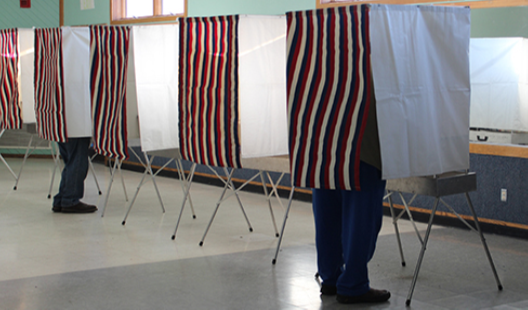
In normative social influence, people conform to the group norm to fit in, to feel good, and to be accepted by the group. However, with informational social influence, people conform because they believe the group is competent and has the correct information, particularly when the task or situation is ambiguous. What type of social influence was operating in the Asch conformity studies? Since the line judgment task was unambiguous, participants did not need to rely on the group for information. Instead, participants complied to fit in and avoid ridicule, an instance of normative social influence.
An example of informational social influence may be what to do in an emergency situation. Imagine that you are in a movie theater watching a film and what seems to be smoke comes in the theater from under the emergency exit door. You are not certain that it is smoke—it might be a special effect for the movie, such as a fog machine. When you are uncertain you will tend to look at the behavior of others in the theater. If other people show concern and get up to leave, you are likely to do the same. However, if others seem unconcerned, you are likely to stay put and continue watching the movie (Figure 12.19).

Stanley Milgram’s Experiment
Conformity is one effect of the influence of others on our thoughts, feelings, and behaviors. Another form of social influence is obedience to authority. Obedience is the change of an individual’s behavior to comply with a demand by an authority figure. People often comply with the request because they are concerned about a consequence if they do not comply. To demonstrate this phenomenon, we review another classic social psychology experiment.
Stanley Milgram was a social psychology professor at Yale who was influenced by the trial of Adolf Eichmann, a Nazi war criminal. Eichmann’s defense for the atrocities he committed was that he was “just following orders.” Milgram (1963) wanted to test the validity of this defense, so he designed an experiment and initially recruited 40 men for his experiment. The volunteer participants were led to believe that they were participating in a study to improve learning and memory. The participants were told that they were to teach other students (learners) correct answers to a series of test items. The participants were shown how to use a device that they were told delivered electric shocks of different intensities to the learners. The participants were told to shock the learners if they gave a wrong answer to a test item—that the shock would help them to learn. The participants believed they gave the learners shocks, which increased in 15-volt increments, all the way up to 450 volts. The participants did not know that the learners were confederates and that the confederates did not actually receive shocks.
In response to a string of incorrect answers from the learners, the participants obediently and repeatedly shocked them. The confederate learners cried out for help, begged the participant teachers to stop, and even complained of heart trouble. Yet, when the researcher told the participant-teachers to continue the shock, 65% of the participants continued the shock to the maximum voltage and to the point that the learner became unresponsive (Figure 12.20). What makes someone obey authority to the point of potentially causing serious harm to another person?

This case is still very applicable today. What does a person do if an authority figure orders something done? What if the person believes it is incorrect, or worse, unethical? In a study by Martin and Bull (2008), midwives privately filled out a questionnaire regarding best practices and expectations in delivering a baby. Then, a more senior midwife and supervisor asked the junior midwives to do something they had previously stated they were opposed to. Most of the junior midwives were obedient to authority, going against their own beliefs. Burger (2009) partially replicated this study. He found among a multicultural sample of women and men that their levels of obedience matched Milgram’s research. Doliński et al. (2017) performed a replication of Burger’s work in Poland and controlled for the gender of both participants and learners, and once again, results that were consistent with Milgram’s original work were observed.
Groupthink
When in group settings, we are often influenced by the thoughts, feelings, and behaviors of people around us. Whether it is due to normative or informational social influence, groups have power to influence individuals. Another phenomenon of group conformity is groupthink. Groupthink is the modification of the opinions of members of a group to align with what they believe is the group consensus (Janis, 1972). In group situations, the group often takes action that individuals would not perform outside the group setting because groups make more extreme decisions than individuals do. Moreover, groupthink can hinder opposing trains of thought. This elimination of diverse opinions contributes to faulty decision by the group.
DIG DEEPER
Groupthink in the U.S. Government
There have been several instances of groupthink in the U.S. government. One example occurred when the United States led a small coalition of nations to invade Iraq in March 2003. This invasion occurred because a small group of advisors and former President George W. Bush were convinced that Iraq represented a significant terrorism threat with a large stockpile of weapons of mass destruction at its disposal. Although some of these individuals may have had some doubts about the credibility of the information available to them at the time, in the end, the group arrived at a consensus that Iraq had weapons of mass destruction and represented a significant threat to national security. It later came to light that Iraq did not have weapons of mass destruction, but not until the invasion was well underway. As a result, 6000 American soldiers were killed and many more civilians died. How did the Bush administration arrive at their conclusions? View this video of Colin Powell, 10 years after his famous United Nations speech, discussing the information he had at the time that his decisions were based on. (“CNN Official Interview: Colin Powell now regrets UN speech about WMDs,” 2010).
Do you see evidence of groupthink?
Why does groupthink occur? There are several causes of groupthink, which makes it preventable. When the group is highly cohesive, or has a strong sense of connection, maintaining group harmony may become more important to the group than making sound decisions. If the group leader is directive and makes his opinions known, this may discourage group members from disagreeing with the leader. If the group is isolated from hearing alternative or new viewpoints, groupthink may be more likely. How do you know when groupthink is occurring?
There are several symptoms of groupthink including the following:
- perceiving the group as invulnerable or invincible—believing it can do no wrong
- believing the group is morally correct
- self-censorship by group members, such as withholding information to avoid disrupting the group consensus
- the quashing of dissenting group members’ opinions
- the shielding of the group leader from dissenting views
- perceiving an illusion of unanimity among group members
- holding stereotypes or negative attitudes toward the out-group or others’ with differing viewpoints (Janis, 1972)
Given the causes and symptoms of groupthink, how can it be avoided? There are several strategies that can improve group decision making including seeking outside opinions, voting in private, having the leader withhold position statements until all group members have voiced their views, conducting research on all viewpoints, weighing the costs and benefits of all options, and developing a contingency plan (Janis, 1972; Mitchell & Eckstein, 2009).
Group Polarization
Another phenomenon that occurs within group settings is group polarization. Group polarization (Teger & Pruitt, 1967) is the strengthening of an original group attitude after the discussion of views within a group. That is, if a group initially favors a viewpoint, after discussion the group consensus is likely a stronger endorsement of the viewpoint. Conversely, if the group was initially opposed to a viewpoint, group discussion would likely lead to stronger opposition. Group polarization explains many actions taken by groups that would not be undertaken by individuals. Group polarization can be observed at political conventions, when platforms of the party are supported by individuals who, when not in a group, would decline to support them. Recently, some theorists have argued that group polarization may be partly responsible for the extreme political partisanship that seems ubiquitous in modern society. Given that people can self-select media outlets that are most consistent with their own political views, they are less likely to encounter opposing viewpoints. Over time, this leads to a strengthening of their own perspective and of hostile attitudes and behaviors towards those with different political ideals. Remarkably, political polarization leads to open levels of discrimination that are on par with, or perhaps exceed, racial discrimination (Iyengar & Westwood, 2015). A more everyday example is a group’s discussion of how attractive someone is. Does your opinion change if you find someone attractive, but your friends do not agree? If your friends vociferously agree, might you then find this person even more attractive?
Social traps refer to situations that arise when individuals or groups of individuals behave in ways that are not in their best interest and that may have negative, long-term consequences. However, once established, a social trap is very difficult to escape. For example, following World War II, the United States and the former Soviet Union engaged in a nuclear arms race. While the presence of nuclear weapons is not in either party’s best interest, once the arms race began, each country felt the need to continue producing nuclear weapons to protect itself from the other.
Social Loafing
Imagine you were just assigned a group project with other students whom you barely know. Everyone in your group will get the same grade. Are you the type who will do most of the work, even though the final grade will be shared? Or are you more likely to do less work because you know others will pick up the slack? Social loafing involves a reduction in individual output on tasks where contributions are pooled. Because each individual’s efforts are not evaluated, individuals can become less motivated to perform well. Karau and Williams (1993) and Simms and Nichols (2014) reviewed the research on social loafing and discerned when it was least likely to happen. The researchers noted that social loafing could be alleviated if, among other situations, individuals knew their work would be assessed by a manager (in a workplace setting) or instructor (in a classroom setting), or if a manager or instructor required group members to complete self-evaluations.
The likelihood of social loafing in student work groups increases as the size of the group increases (Shepperd & Taylor, 1999). According to Kamau and Williams (1993), college students were the population most likely to engage in social loafing. Their study also found that women and participants from collectivistic cultures were less likely to engage in social loafing, explaining that their group orientation may account for this.
College students could work around social loafing or “free-riding” by suggesting to their professors use of a flocking method to form groups. Harding (2018) compared groups of students who had self-selected into groups for class to those who had been formed by flocking, which involves assigning students to groups who have similar schedules and motivations. Not only did she find that students reported less “free riding,” but that they also did better in the group assignments compared to those whose groups were self-selected.
Interestingly, the opposite of social loafing occurs when the task is complex and difficult (Bond & Titus, 1983; Geen, 1989). In a group setting, such as the student work group, if your individual performance cannot be evaluated, there is less pressure for you to do well, and thus less anxiety or physiological arousal (Latané, Williams, & Harkens, 1979). This puts you in a relaxed state in which you can perform your best, if you choose (Zajonc, 1965). If the task is a difficult one, many people feel motivated and believe that their group needs their input to do well on a challenging project (Jackson & Williams, 1985).
Deindividuation
Another way that being part of a group can affect behavior is exhibited in instances in which deindividuation occurs. Deindividuation refers to situations in which a person may feel a sense of anonymity and therefore a reduction in accountability and sense of self when among others. Deindividuation is often pointed to in cases in which mob or riot-like behaviors occur (Zimbardo, 1969), but research on the subject and the role that deindividuation plays in such behaviors has resulted in inconsistent results (as discussed in Granström, Guvå, Hylander, & Rosander, 2009).
Table 12.2 summarizes the types of social influence you have learned about in this chapter.
| Types of Social Influence | |
|---|---|
| Type of Social Influence | Description |
| Conformity | Changing your behavior to go along with the group even if you do not agree with the group |
| Compliance | Going along with a request or demand |
| Normative social influence | Conformity to a group norm to fit in, feel good, and be accepted by the group |
| Informational social influence | Conformity to a group norm prompted by the belief that the group is competent and has the correct information |
| Obedience | Changing your behavior to please an authority figure or to avoid aversive consequences |
| Groupthink | Tendency to prioritize group cohesion over critical thinking that might lead to poor decision making; more likely to occur when there is perceived unanimity among the group |
| Group polarization | Strengthening of the original group attitude after discussing views within a group |
| Social facilitation | Improved performance when an audience is watching versus when the individual performs the behavior alone |
| Social loafing | Exertion of less effort by a person working in a group because individual performance cannot be evaluated separately from the group, thus causing performance decline on easy tasks |
| Deindividuation | Group situation in which a person may feel a sense of anonymity and a resulting reduction in accountability and sense of self |
12.4 TEST YOURSELF
12.5 Prejudice and Discrimination
LEARNING OBJECTIVES
By the end of this section, you will be able to:
- Define and distinguish among prejudice, stereotypes, and discrimination
- Provide examples of prejudice, stereotypes, and discrimination
- Explain why prejudice and discrimination exist
Human conflict can result in crime, war, and mass murder, such as genocide. Prejudice and discrimination often are root causes of human conflict, which explains how strangers come to hate one another to the extreme of causing others harm. Prejudice and discrimination affect everyone. In this section we will examine the definitions of prejudice and discrimination, examples of these concepts, and causes of these biases.

Understanding Prejudice and Discrimination
Humans are very diverse and although we share many similarities, we also have many differences. The social groups we belong to help form our identities (Tajfel, 1974). These differences may be difficult for some people to reconcile, which may lead to prejudice toward people who are different. Prejudice is a negative attitude and feeling toward an individual based solely on one’s membership in a particular social group (Allport, 1954; Brown, 2010). Prejudice is common against people who are members of an unfamiliar cultural group. Thus, certain types of education, contact, interactions, and building relationships with members of different cultural groups can reduce the tendency toward prejudice. In fact, simply imagining interacting with members of different cultural groups might affect prejudice. Indeed, when experimental participants were asked to imagine themselves positively interacting with someone from a different group, this led to an increased positive attitude toward the other group and an increase in positive traits associated with the other group. Furthermore, imagined social interaction can reduce anxiety associated with inter-group interactions (Crisp & Turner, 2009). What are some examples of social groups that you belong to that contribute to your identity? Social groups can include gender, race, ethnicity, nationality, social class, religion, sexual orientation, profession, and many more. And, as is true for social roles, you can simultaneously be a member of more than one social group. An example of prejudice is having a negative attitude toward people who are not born in the United States. Although people holding this prejudiced attitude do not know all people who were not born in the United States, they dislike them due to their status as foreigners.
Can you think of a prejudiced attitude you have held toward a group of people? How did your prejudice develop? Prejudice often begins in the form of a stereotype—that is, a specific belief or assumption about individuals based solely on their membership in a group, regardless of their individual characteristics. Stereotypes become overgeneralized and applied to all members of a group. For example, someone holding prejudiced attitudes toward older adults, may believe that older adults are slow and incompetent (Cuddy, Norton, & Fiske, 2005; Nelson, 2004). We cannot possibly know each individual person of advanced age to know that all older adults are slow and incompetent. Therefore, this negative belief is overgeneralized to all members of the group, even though many of the individual group members may, in fact, be spry and intelligent.
Another example of a well-known stereotype involves beliefs about racial differences among athletes. As Hodge, Burden, Robinson, and Bennett (2008) point out, Black male athletes are often believed to be more athletic, yet less intelligent, than their White male counterparts. These beliefs persist despite a number of high profile examples to the contrary. Sadly, such beliefs often influence how these athletes are treated by others and how they view themselves and their own capabilities. Whether or not you agree with a stereotype, stereotypes are generally well-known within a given culture (Devine, 1989).
Sometimes people will act on their prejudiced attitudes toward a group of people, and this behavior is known as discrimination. Discrimination is negative action toward an individual as a result of one’s membership in a particular group (Allport, 1954; Dovidio & Gaertner, 2004). As a result of holding negative beliefs (stereotypes) and negative attitudes (prejudice) about a particular group, people often treat the target of prejudice poorly, such as excluding older adults from their circle of friends. An example of a psychologist experiencing gender discrimination is found in the life and studies of Mary Whiton Calkins. Calkins was given special permission to attend graduate seminars at Harvard (at that time in the late 1880s, Harvard did not accept women) and at one point was the sole student of the famous psychologist William James. She passed all the requirements needed for a PhD and was described by psychologist Hugo Münsterberg as “one of the strongest professors of psychology in this country.” However, Harvard refused to grant Calkins a PhD because she was a woman (Harvard University, 2019). Table 12.3 summarizes the characteristics of stereotypes, prejudice, and discrimination. Have you ever been the target of discrimination? If so, how did this negative treatment make you feel?
| Connecting Stereotypes, Prejudice, and Discrimination | |||
|---|---|---|---|
| Item | Function | Connection | Example |
| Stereotype | Cognitive; thoughts about people | Overgeneralized beliefs about people may lead to prejudice. | “Yankees fans are arrogant and obnoxious.” |
| Prejudice | Affective; feelings about people, both positive and negative | Feelings may influence treatment of others, leading to discrimination. | “I hate Yankees fans; they make me angry.” |
| Discrimination | Behavior; positive or negative treatment of others | Holding stereotypes and harboring prejudice may lead to excluding, avoiding, and biased treatment of group members. | “I would never hire nor become friends with a person if I knew he or she were a Yankees fan.” |
So far, we’ve discussed stereotypes, prejudice, and discrimination as negative thoughts, feelings, and behaviors because these are typically the most problematic. However, it is important to also point out that people can hold positive thoughts, feelings, and behaviors toward individuals based on group membership; for example, they would show preferential treatment for people who are like themselves—that is, who share the same gender, race, or favorite sports team.
Types of Prejudice and Discrimination
When we meet strangers we automatically process three pieces of information about them: their race, gender, and age (Ito & Urland, 2003). Why are these aspects of an unfamiliar person so important? Why don’t we instead notice whether their eyes are friendly, whether they are smiling, their height, the type of clothes they are wearing? Although these secondary characteristics are important in forming a first impression of a stranger, the social categories of race, gender, and age provide a wealth of information about an individual. This information, however, often is based on stereotypes. We may have different expectations of strangers depending on their race, gender, and age. What stereotypes and prejudices do you hold about people who are from a race, gender, and age group different from your own?
Racism
Racism is prejudice and discrimination against an individual based solely on one’s membership in a specific racial group (such as toward African Americans, Asian Americans, Latinos, Native Americans, European Americans). What are some stereotypes of various racial or ethnic groups? Research suggests cultural stereotypes for Asian Americans include cold, sly, and intelligent; for Latinos, cold and unintelligent; for European Americans, cold and intelligent; and for African Americans, aggressive, athletic, and more likely to be law breakers (Devine & Elliot, 1995; Fiske, Cuddy, Glick, & Xu, 2002; Sommers & Ellsworth, 2000; Dixon & Linz, 2000).
Racism exists for many racial and ethnic groups. For example, Blacks are significantly more likely to have their vehicles searched during traffic stops than Whites, particularly when Blacks are driving in predominately White neighborhoods, a phenomenon often termed “DWB” or “driving while Black” (Rojek, Rosenfeld, & Decker, 2012).
Mexican Americans and other Latino groups also are targets of racism from the police and other members of the community. For example, when purchasing items with a personal check, Latino shoppers are more likely than White shoppers to be asked to show formal identification (Dovidio et al., 2010).
In one case of alleged harassment by the police, several East Haven, Connecticut, police officers were arrested on federal charges due to reportedly continued harassment and brutalization of Latinos. When the accusations came out, the mayor of East Haven was asked, “What are you doing for the Latino community today?” The Mayor responded, “I might have tacos when I go home, I’m not quite sure yet” (“East Haven Mayor,” 2012). This statement undermines the important issue of racial profiling and police harassment of Latinos, while belittling Latino culture by emphasizing an interest in a food product stereotypically associated with Latinos.
Racism is prevalent toward many other groups in the United States including Native Americans, Arab Americans, Jewish Americans, and Asian Americans. Have you experienced or witnessed racism toward any of these racial or ethnic groups? Are you aware of racism in your community?
One reason modern forms of racism, and prejudice in general, are hard to detect is related to the dual attitudes model (Wilson, Lindsey, & Schooler, 2000). Humans have two forms of attitudes: explicit attitudes, which are conscious and controllable, and implicit attitudes, which are unconscious and uncontrollable (Devine, 1989; Olson & Fazio, 2003). Because holding egalitarian views is socially desirable (Plant & Devine, 1998), most people do not show extreme racial bias or other prejudices on measures of their explicit attitudes. However, measures of implicit attitudes often show evidence of mild to strong racial bias or other prejudices (Greenwald, McGee, & Schwartz, 1998; Olson & Fazio, 2003).
Sexism
Sexism is prejudice and discrimination toward individuals based on their sex. Typically, sexism takes the form of men holding biases against women, but either sex can show sexism toward their own or their opposite sex. Like racism, sexism may be subtle and difficult to detect. Common forms of sexism in modern society include gender role expectations, such as expecting women to be the caretakers of the household. Sexism also includes people’s expectations for how members of a gender group should behave. For example, women are expected to be friendly, passive, and nurturing, and when women behave in an unfriendly, assertive, or neglectful manner they often are disliked for violating their gender role (Rudman, 1998). Research by Laurie Rudman (1998) finds that when female job applicants self-promote, they are likely to be viewed as competent, but they may be disliked and are less likely to be hired because they violated gender expectations for modesty. Sexism can exist on a societal level such as in hiring, employment opportunities, and education. Women are less likely to be hired or promoted in male-dominated professions such as engineering, aviation, and construction (Figure 12.22) (Blau, Ferber, & Winkler, 2010; Ceci & Williams, 2011). Have you ever experienced or witnessed sexism? Think about your family members’ jobs or careers. Why do you think there are differences in the jobs women and men have, such as more women nurses but more male surgeons (Betz, 2008)?

People often form judgments and hold expectations about people based on their age. These judgments and expectations can lead to ageism, or prejudice and discrimination toward individuals based solely on their age. Think of expectations you hold for older adults. How could someone’s expectations influence the feelings they hold toward individuals from older age groups? Ageism is widespread in U.S. culture (Nosek, 2005), and a common ageist attitude toward older adults is that they are incompetent, physically weak, and slow (Greenberg, Schimel, & Martens, 2002) and some people consider older adults less attractive. Chang, Kannoth, Levy, Wang, Lee, and Levy (2020) reported on relationships between ageism and health outcomes over a 40-year-plus period from countries around the world. Across 11 health domains, people over 50 were likely to experience ageism most often in the form of being denied access to health services and work opportunities. Some cultures, however, including some Asian, Latino, and African American cultures, both outside and within the United States afford older adults respect and honor.
Typically, ageism occurs against older adults, but ageism also can occur toward younger adults. What expectations do you hold toward younger people? Does society expect younger adults to be immature and irresponsible? Raymer, Reed, Spiegel, and Purvanova (2017) examined ageism against younger workers. They found that older workers endorsed negative stereotypes of younger workers, believing that they had more work deficit characteristics (including perceptions of incompetence). How might these forms of ageism affect a younger and older adult who are applying for a sales clerk position?
Homophobia
Another form of prejudice is homophobia: an umbrella term referring to prejudice and discrimination of individuals based solely on their sexual orientation, which is often applied to bisexual, lesbian, gay, and other non-heterosexual people. Transphobia is the hatred or fear of those who are perceived to break or blur stereotypical gender roles, often expressed as stereotyping, discrimination, harassment and/or violence. Like ageism, homophobia is a widespread prejudice in U.S. society that is tolerated by many people (Herek & McLemore, 2013; Nosek, 2005). Negative feelings often result in discrimination, such as the exclusion of lesbian, gay, bisexual, transgender, and queer (LGBTQ+) people from social groups and the avoidance of LGBTQ+ neighbors and co-workers. This discrimination also extends to employers deliberately declining to hire qualified LGBTQ+ job applicants, a practice officially outlawed by a 2020 Surpreme Court decision but which remains a significant issue. Have you experienced or witnessed homophobia? If so, what stereotypes, prejudiced attitudes, and discrimination were evident?
DIG DEEPER
Research into Homophobia
Some people are quite passionate in their hatred for nonheterosexuals in our society. In some cases, people have been tortured and/or murdered simply because they were not straight. This passionate response has led some researchers to question what motives might exist for homophobic people. Adams, Wright, & Lohr (1996) conducted a study investigating this issue and their results were quite an eye-opener.
In this experiment, male college students were given a scale that assessed how homophobic they were; those with extreme scores were recruited to participate in the experiment. In the end, 64 men agreed to participate and were split into 2 groups: homophobic men and nonhomophobic men. Both groups of men were fitted with a penile plethysmograph, an instrument that measures changes in blood flow to the penis and serves as an objective measurement of sexual arousal.
All men were shown segments of sexually explicit videos. One of these videos involved a sexual interaction between a man and a woman (straight clip). One video displayed two females engaged in a sexual interaction (lesbian clip), and the final video displayed two men engaged in a sexual interaction (gay clip). Changes in penile tumescence (a measure of physiological genital arousal) were recorded during all three clips, and a subjective measurement of sexual arousal was also obtained. While both groups of men became sexually aroused to the straight and lesbian video clips, only those men who were identified as homophobic showed sexual arousal to the gay male video clip. While all men reported that their erections indicated arousal for the straight and lesbian clips, the homophobic men indicated that they were not sexually aroused (despite their erections) to the gay clips. Adams et al. (1996) suggest that these findings may indicate that homophobia is related to gay arousal that the homophobic individuals either deny or are unaware.
Why Do Prejudice and Discrimination Exist?
Prejudice and discrimination persist in society due to social learning and conformity to social norms. Children learn prejudiced attitudes and beliefs from society: their parents, teachers, friends, the media, and other sources of socialization, such as Facebook (O’Keeffe & Clarke-Pearson, 2011). If certain types of prejudice and discrimination are acceptable in a society, there may be normative pressures to conform and share those prejudiced beliefs, attitudes, and behaviors. For example, public and private schools are still somewhat segregated by social class. Historically, only children from wealthy families could afford to attend private schools, whereas children from middle- and low-income families typically attended public schools. If a child from a low-income family received a merit scholarship to attend a private school, how might the child be treated by classmates? Can you recall a time when you held prejudiced attitudes or beliefs or acted in a discriminatory manner because your group of friends expected you to?
Stereotypes and Self-Fulfilling Prophecy
When we hold a stereotype about a person, we have expectations that he or she will fulfill that stereotype. A self-fulfilling prophecy is an expectation held by a person that alters his or her behavior in a way that tends to make it true. When we hold stereotypes about a person, we tend to treat the person according to our expectations. This treatment can influence the person to act according to our stereotypic expectations, thus confirming our stereotypic beliefs. Research by Rosenthal and Jacobson (1968) found that disadvantaged students whose teachers expected them to perform well had higher grades than disadvantaged students whose teachers expected them to do poorly.
Consider this example of cause and effect in a self-fulfilling prophecy: If an employer expects an openly gay male job applicant to be incompetent, the potential employer might treat the applicant negatively during the interview by engaging in less conversation, making little eye contact, and generally behaving coldly toward the applicant (Hebl, Foster, Mannix, & Dovidio, 2002). In turn, the job applicant will perceive that the potential employer dislikes him, and he will respond by giving shorter responses to interview questions, making less eye contact, and generally disengaging from the interview. After the interview, the employer will reflect on the applicant’s behavior, which seemed cold and distant, and the employer will conclude, based on the applicant’s poor performance during the interview, that the applicant was in fact incompetent. Thus, the employer’s stereotype—gay men are incompetent and do not make good employees—is reinforced. Do you think this job applicant is likely to be hired? Treating individuals according to stereotypic beliefs can lead to prejudice and discrimination.
Another dynamic that can reinforce stereotypes is confirmation bias. When interacting with the target of our prejudice, we tend to pay attention to information that is consistent with our stereotypic expectations and ignore information that is inconsistent with our expectations. In this process, known as confirmation bias, we seek out information that supports our stereotypes and ignore information that is inconsistent with our stereotypes (Wason & Johnson-Laird, 1972). In the job interview example, the employer may not have noticed that the job applicant was friendly and engaging, and that he provided competent responses to the interview questions in the beginning of the interview. Instead, the employer focused on the job applicant’s performance in the later part of the interview, after the applicant changed his demeanor and behavior to match the interviewer’s negative treatment. Have you ever fallen prey to the self-fulfilling prophecy or confirmation bias, either as the source or target of such bias? How might we stop the cycle of the self-fulfilling prophecy?
In-Groups and Out-Groups
As discussed previously in this section, we all belong to a gender, race, age, and social economic group. These groups provide a powerful source of our identity and self-esteem (Tajfel & Turner, 1979). These groups serve as our in-groups. An in-group is a group that we identify with or see ourselves as belonging to. A group that we don’t belong to, or an out-group, is a group that we view as fundamentally different from us. For example, if you are female, your gender in-group includes all females, and your gender out-group includes all males (Figure 12.23). People often view gender groups as being fundamentally different from each other in personality traits, characteristics, social roles, and interests. Because we often feel a strong sense of belonging and emotional connection to our in-groups, we develop in-group bias: a preference for our own group over other groups. This in-group bias can result in prejudice and discrimination because the out-group is perceived as different and is less preferred than our in-group.

One function of prejudice is to help us feel good about ourselves and maintain a positive self-concept. This need to feel good about ourselves extends to our in-groups: We want to feel good and protect our in-groups. We seek to resolve threats individually and at the in-group level. This often happens by blaming an out-group for the problem. Scapegoating is the act of blaming an out-group when the in-group experiences frustration or is blocked from obtaining a goal (Allport, 1954).
12.5 TEST YOURSELF
12.6 Aggression
LEARNING OBJECTIVES
By the end of this section, you will be able to:
- Define aggression
- Define cyberbullying
- Describe the bystander effect
Throughout this chapter we have discussed how people interact and influence one another’s thoughts, feelings, and behaviors in both positive and negative ways. People can work together to achieve great things, such as helping each other in emergencies: recall the heroism displayed during the 9/11 terrorist attacks. People also can do great harm to one another, such as conforming to group norms that are immoral and obeying authority to the point of murder: consider the mass conformity of Nazis during WWII. In this section we will discuss a negative side of human behavior—aggression.
A number of researchers have explored ways to reduce prejudice. One of the earliest was a study by Sherif et al. (1961) known as the Robbers Cave experiment. They found that when two opposing groups at a camp worked together toward a common goal, prejudicial attitudes between the groups decreased (Gaertner, Dovidio, Banker, Houlette, Johnson, & McGlynn, 2000). Focusing on superordinate goals was the key to attitude change in the research. Another study examined the jigsaw classroom, a technique designed by Aronson and Bridgeman in an effort to increase success in desegregated classrooms. In this technique, students work on an assignment in groups inclusive of various races and abilities. They are assigned tasks within their group, then collaborate with peers from other groups who were assigned the same task, and then report back to their original group. Walker and Crogan (1998) noted that the jigsaw classroom reduced potential for prejudice in Australia, as diverse students worked together on projects needing all of the pieces to succeed. This research suggests that anything that can allow individuals to work together toward common goals can decrease prejudicial attitudes. Obviously, the application of such strategies in real-world settings would enhance opportunities for conflict resolution.
Aggression
Humans engage in aggression when they seek to cause harm or pain to another person. Aggression takes two forms depending on one’s motives: hostile or instrumental. Hostile aggression is motivated by feelings of anger with intent to cause pain; a fight in a bar with a stranger is an example of hostile aggression. In contrast, instrumental aggression is motivated by achieving a goal and does not necessarily involve intent to cause pain (Berkowitz, 1993); a contract killer who murders for hire displays instrumental aggression.
There are many different theories as to why aggression exists. Some researchers argue that aggression serves an evolutionary function (Buss, 2004). Men are more likely than women to show aggression (Wilson & Daly, 1985). From the perspective of evolutionary psychology, human male aggression, like that in nonhuman primates, likely serves to display dominance over other males, both to protect a mate and to perpetuate the male’s genes (Figure 12.24). Sexual jealousy is part of male aggression; males endeavor to make sure their mates are not copulating with other males, thus ensuring their own paternity of the female’s offspring. Although aggression provides an obvious evolutionary advantage for men, women also engage in aggression. Women typically display more indirect forms of aggression, with their aggression serving as a means to an end (Dodge & Schwartz, 1997). For example, women may express their aggression covertly by communication that impairs the social standing of another person. Another theory that explains one of the functions of human aggression is frustration aggression theory (Dollard, Doob, Miller, Mowrer, & Sears, 1939). This theory states that when humans are prevented from achieving an important goal, they become frustrated and aggressive.

Bullying
Another form of aggression is bullying. As you learn in your study of child development, socializing and playing with other children is beneficial for children’s psychological development. However, as you may have experienced as a child, not all play behavior has positive outcomes. Some children are aggressive and want to play roughly. Other children are selfish and do not want to share toys. One form of negative social interactions among children that has become a national concern is bullying. Bullying is repeated negative treatment of another person, often an adolescent, over time (Olweus, 1993). A one-time incident in which one child hits another child on the playground would not be considered bullying: Bullying is repeated behavior. The negative treatment typical in bullying is the attempt to inflict harm, injury, or humiliation, and bullying can include physical or verbal attacks. However, bullying doesn’t have to be physical or verbal, it can be psychological. Research finds gender differences in how girls and boys bully others (American Psychological Association, 2010; Olweus, 1993). Boys tend to engage in direct, physical aggression such as physically harming others. Girls tend to engage in indirect, social forms of aggression such as spreading rumors, ignoring, or socially isolating others. Based on what you have learned about child development and social roles, why do you think boys and girls display different types of bullying behavior?
Bullying involves three parties: the bully, the victim, and witnesses or bystanders. The act of bullying involves an imbalance of power with the bully holding more power—physically, emotionally, and/or socially over the victim. The experience of bullying can be positive for the bully, who may enjoy a boost to self-esteem. However, there are several negative consequences of bullying for the victim, and also for the bystanders. How do you think bullying negatively impacts adolescents? Being the victim of bullying is associated with decreased mental health, including experiencing anxiety and depression (APA, 2010). Victims of bullying may underperform in schoolwork (Bowen, 2011). Bullying also can result in the victim committing suicide (APA, 2010). How might bullying negatively affect witnesses?
Although there is not one single personality profile for who becomes a bully and who becomes a victim of bullying (APA, 2010), researchers have identified some patterns in children who are at a greater risk of being bullied (Olweus, 1993):
- Children who are emotionally reactive are at a greater risk for being bullied. Bullies may be attracted to children who get upset easily because the bully can quickly get an emotional reaction from them.
- Children who are different from others are likely to be targeted for bullying. Children who are overweight, cognitively impaired, or racially or ethnically different from their peer group may be at higher risk.
- Gay, lesbian, bisexual, and transgender teens are at very high risk of being bullied and hurt due to their sexual orientation.
Cyberbullying
With the rapid growth of technology, and widely available mobile technology and social networking media, a new form of bullying has emerged: cyberbullying (Hoff & Mitchell, 2009). Cyberbullying, like bullying, is repeated behavior that is intended to cause psychological or emotional harm to another person. What is unique about cyberbullying is that it is typically covert, concealed, done in private, and the bully can remain anonymous. This anonymity gives the bully power, and the victim may feel helpless, unable to escape the harassment, and unable to retaliate (Spears, Slee, Owens, & Johnson, 2009).
Cyberbullying can take many forms, including harassing a victim by spreading rumors, creating a website defaming the victim, and ignoring, insulting, laughing at, or teasing the victim (Spears et al., 2009). In cyberbullying, it is more common for girls to be the bullies and victims because cyberbullying is nonphysical and is a less direct form of bullying (Figure 12.25) (Hoff & Mitchell, 2009). Interestingly, girls who become cyberbullies often have been the victims of cyberbullying at one time (Vandebosch & Van Cleemput, 2009). The effects of cyberbullying are just as harmful as traditional bullying and include the victim feeling frustration, anger, sadness, helplessness, powerlessness, and fear. Victims will also experience lower self-esteem (Hoff & Mitchell, 2009; Spears et al., 2009). Furthermore, recent research suggests that both cyberbullying victims and perpetrators are more likely to experience suicidal ideation, and they are more likely to attempt suicide than individuals who have no experience with cyberbullying (Hinduja & Patchin, 2010). What features of technology make cyberbullying easier and perhaps more accessible to young adults? What can parents, teachers, and social networking websites, like Facebook, do to prevent cyberbullying?

The Bystander Effect
The discussion of bullying highlights the problem of witnesses not intervening to help a victim. Researchers Latané and Darley (1968) described a phenomenon called the bystander effect. The bystander effect is a phenomenon in which a witness or bystander does not volunteer to help a victim or person in distress. Instead, they just watch what is happening. Social psychologists hold that we make these decisions based on the social situation, not our own personality variables. The impetus behind the bystander effect was the murder of a young woman named Kitty Genovese in 1964. The story of her tragic death took on a life of its own when it was reported that none of her neighbors helped her or called the police when she was being attacked. However, Kassin (2017) noted that her killer was apprehended due to neighbors who called the police when they saw him committing a burglary days later. Not only did bystanders indeed intervene in her murder (one man who shouted at the killer, a woman who said she called the police, and a friend who comforted her in her last moments), but other bystanders intervened in the capture of the murderer. Social psychologists claim that diffusion of responsibility is the likely explanation. Diffusion of responsibility is the tendency for no one in a group to help because the responsibility to help is spread throughout the group (Bandura, 1999). Because there were many witnesses to the attack on Genovese, as evidenced by the number of lit apartment windows in the building, individuals assumed someone else must have already called the police. The responsibility to call the police was diffused across the number of witnesses to the crime. Have you ever passed an accident on the freeway and assumed that a victim or certainly another motorist has already reported the accident? In general, the greater the number of bystanders, the less likely any one person will help.
12.6 TEST YOURSELF
12.7 Prosocial Behavior
LEARNING OBJECTIVES
By the end of this section, you will be able to:
- Describe altruism
- Describe conditions that influence the formation of relationships
- Identify what attracts people to each other
- Describe the triangular theory of love
- Explain social exchange theory in relationships
You’ve learned about many of the negative behaviors of social psychology, but the field also studies many positive social interactions and behaviors. What makes people like each other? With whom are we friends? Whom do we date? Researchers have documented several features of the situation that influence whether we form relationships with others. There are also universal traits that humans find attractive in others. In this section we discuss conditions that make forming relationships more likely, what we look for in friendships and romantic relationships, the different types of love, and a theory explaining how our relationships are formed, maintained, and terminated.
Prosocial Behavior and Altruism
Do you voluntarily help others? Voluntary behavior with the intent to help other people is called prosocial behavior. Why do people help other people? Is personal benefit such as feeling good about oneself the only reason people help one another? Research suggests there are many other reasons. Altruism is people’s desire to help others even if the costs outweigh the benefits of helping. In fact, people acting in altruistic ways may disregard the personal costs associated with helping (Figure 12.26). For example, news accounts of the 9/11 terrorist attacks on the World Trade Center in New York reported an employee in the first tower helped his co-workers make it to the exit stairwell. After helping a co-worker to safety he went back in the burning building to help additional co-workers. In this case the costs of helping were great, and the hero lost his life in the destruction (Stewart, 2002).

Forming Relationships
What do you think is the single most influential factor in determining with whom you become friends and whom you form romantic relationships? You might be surprised to learn that the answer is simple: the people with whom you have the most contact. This most important factor is proximity. You are more likely to be friends with people you have regular contact with. For example, there are decades of research that shows that you are more likely to become friends with people who live in your dorm, your apartment building, or your immediate neighborhood than with people who live farther away (Festinger, Schachler, & Back, 1950). It is simply easier to form relationships with people you see often because you have the opportunity to get to know them.
Similarity is another factor that influences who we form relationships with. We are more likely to become friends or lovers with someone who is similar to us in background, attitudes, and lifestyle. In fact, there is no evidence that opposites attract. Rather, we are attracted to people who are most like us (Figure 12.27) (McPherson, Smith-Lovin, & Cook, 2001). Why do you think we are attracted to people who are similar to us? Sharing things in common will certainly make it easy to get along with others and form connections. When you and another person share similar music taste, hobbies, food preferences, and so on, deciding what to do with your time together might be easy. Homophily is the tendency for people to form social networks, including friendships, marriage, business relationships, and many other types of relationships, with others who are similar (McPherson et al., 2001).

Once we form relationships with people, we desire reciprocity. Reciprocity is the give and take in relationships. We contribute to relationships, but we expect to receive benefits as well. That is, we want our relationships to be a two way street. We are more likely to like and engage with people who like us back. Self-disclosure is part of the two way street. Self-disclosure is the sharing of personal information (Laurenceau, Barrett, & Pietromonaco, 1998). We form more intimate connections with people with whom we disclose important information about ourselves. Indeed, self-disclosure is a characteristic of healthy intimate relationships, as long as the information disclosed is consistent with our own views (Cozby, 1973).
Attraction
We have discussed how proximity and similarity lead to the formation of relationships, and that reciprocity and self-disclosure are important for relationship maintenance. But, what features of a person do we find attractive? We don’t form relationships with everyone that lives or works near us, so how is it that we decide which specific individuals we will select as friends and lovers?
Researchers have documented several characteristics that humans find attractive. First we look for friends and lovers who are physically attractive. People differ in what they consider attractive, and attractiveness is culturally influenced. Research, however, suggests that some universally attractive features in women include large eyes, high cheekbones, a narrow jaw line, a slender build (Buss, 1989), and a lower waist-to-hip ratio (Singh, 1993). For men, attractive traits include being tall, having broad shoulders, and a narrow waist (Buss, 1989). Both men and women with high levels of facial and body symmetry are generally considered more attractive than asymmetric individuals (Fink, Neave, Manning, & Grammer, 2006; Penton-Voak et al., 2001; Rikowski & Grammer, 1999). Social traits that people find attractive in potential female mates include warmth, affection, and social skills; in males, the attractive traits include achievement, leadership qualities, and job skills (Regan & Berscheid, 1997). Although humans want mates who are physically attractive, this does not mean that we look for the most attractive person possible. In fact, this observation has led some to propose what is known as the matching hypothesis which asserts that people tend to pick someone they view as their equal in physical attractiveness and social desirability (Taylor, Fiore, Mendelsohn, & Cheshire, 2011). For example, you and most people you know likely would say that a very attractive movie star is out of your league. So, even if you had proximity to that person, you likely would not ask them out on a date because you believe you likely would be rejected. People weigh a potential partner’s attractiveness against the likelihood of success with that person. If you think you are particularly unattractive (even if you are not), you likely will seek partners that are fairly unattractive (that is, unattractive in physical appearance or in behavior).
Sternberg’s Triangular Theory of Love
We typically love the people with whom we form relationships, but the type of love we have for our family, friends, and lovers differs. Robert Sternberg (1986) proposed that there are three components of love: intimacy, passion, and commitment. These three components form a triangle that defines multiple types of love: this is known as Sternberg’s triangular theory of love (Figure 12.28). Intimacy is the sharing of details and intimate thoughts and emotions. Passion is the physical attraction—the flame in the fire. Commitment is standing by the person—the “in sickness and health” part of the relationship.
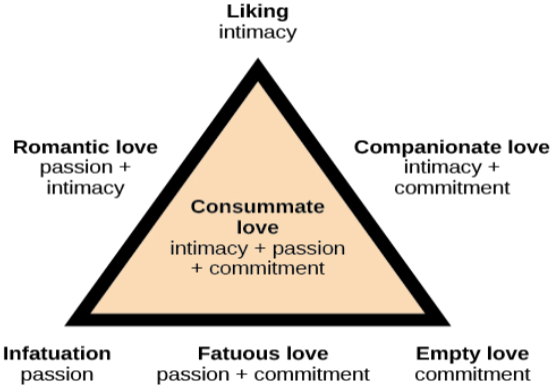

We have discussed why we form relationships, what attracts us to others, and different types of love. But what determines whether we are satisfied with and stay in a relationship? One theory that provides an explanation is social exchange theory. According to social exchange theory, we act as naïve economists in keeping a tally of the ratio of costs and benefits of forming and maintaining a relationship with others (Figure 12.30) (Rusbult & Van Lange, 2003).
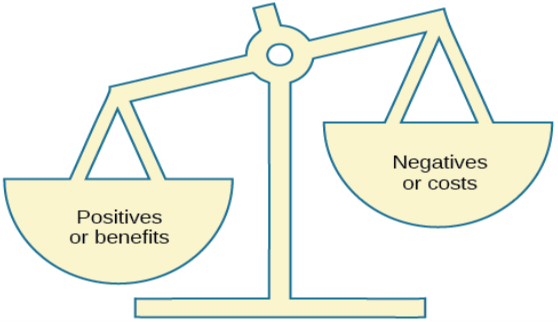
12.7 TEST YOURSELF
Summary
12.1 What is Social Psychology?
Social psychology is the subfield of psychology that studies the power of the situation to influence individuals’ thoughts, feelings, and behaviors. Psychologists categorize the causes of human behavior as those due to internal factors, such as personality, or those due to external factors, such as cultural and other social influences. Behavior is better explained, however, by using both approaches. Lay people tend to over-rely on dispositional explanations for behavior and ignore the power of situational influences, a perspective called the fundamental attribution error. People from individualistic cultures are more likely to display this bias versus people from collectivistic cultures. Our explanations for our own and others behaviors can be biased due to not having enough information about others’ motivations for behaviors and by providing explanations that bolster our self-esteem.
12.2 Self-presentation
Human behavior is largely influenced by our social roles, norms, and scripts. In order to know how to act in a given situation, we have shared cultural knowledge of how to behave depending on our role in society. Social norms dictate the behavior that is appropriate or inappropriate for each role. Each social role has scripts that help humans learn the sequence of appropriate behaviors in a given setting. The famous Stanford prison experiment is an example of how the power of the situation can dictate the social roles, norms, and scripts we follow in a given situation, even if this behavior is contrary to our typical behavior.
12.3 Attitudes and Persuasion
Attitudes are our evaluations or feelings toward a person, idea, or object and typically are positive or negative. Our attitudes and beliefs are influenced not only by external forces, but also by internal influences that we control. An internal form of attitude change is cognitive dissonance or the tension we experience when our thoughts, feelings, and behaviors are in conflict. In order to reduce dissonance, individuals can change their behavior, attitudes, or cognitions, or add a new cognition. External forces of persuasion include advertising; the features of advertising that influence our behaviors include the source, message, and audience. There are two primary routes to persuasion. The central route to persuasion uses facts and information to persuade potential consumers. The peripheral route uses positive association with cues such as beauty, fame, and positive emotions.
12.4 Conformity, Compliance , and Obedience
The power of the situation can lead people to conform, or go along with the group, even in the face of inaccurate information. Conformity to group norms is driven by two motivations, the desire to fit in and be liked and the desire to be accurate and gain information from the group. Authority figures also have influence over our behaviors, and many people become obedient and follow orders even if the orders are contrary to their personal values. Conformity to group pressures can also result in groupthink, or the faulty decision-making process that results from cohesive group members trying to maintain group harmony. Group situations can improve human behavior through facilitating performance on easy tasks, but inhibiting performance on difficult tasks. The presence of others can also lead to social loafing when individual efforts cannot be evaluated.
12.5 Prejudice and Discrimination
As diverse individuals, humans can experience conflict when interacting with people who are different from each other. Prejudice, or negative feelings and evaluations, is common when people are from a different social group (i.e., out-group). Negative attitudes toward out-groups can lead to discrimination. Prejudice and discrimination against others can be based on gender, race, ethnicity, social class, sexual orientation, or a variety of other social identities. In-group’s who feel threatened may blame the out-groups for their plight, thus using the out-group as a scapegoat for their frustration.
12.6 Aggression
Aggression is seeking to cause another person harm or pain. Hostile aggression is motivated by feelings of anger with intent to cause pain, and instrumental aggression is motivated by achieving a goal and does not necessarily involve intent to cause pain Bullying is an international public health concern that largely affects the adolescent population. Bullying is repeated behaviors that are intended to inflict harm on the victim and can take the form of physical, psychological, emotional, or social abuse. Bullying has negative mental health consequences for youth including suicide. Cyberbullying is a newer form of bullying that takes place in an online environment where bullies can remain anonymous and victims are helpless to address the harassment. Despite the social norm of helping others in need, when there are many bystanders witnessing an emergency, diffusion of responsibility will lead to a lower likelihood of any one person helping.
12.7 Prosocial Behavior
Altruism is a pure form of helping others out of empathy, which can be contrasted with egoistic motivations for helping. Forming relationships with others is a necessity for social beings. We typically form relationships with people who are close to us in proximity and people with whom we share similarities. We expect reciprocity and self-disclosure in our relationships. We also want to form relationships with people who are physically attractive, though standards for attractiveness vary by culture and gender. There are many types of love that are determined by various combinations of intimacy, passion, and commitment; consummate love, which is the ideal form of love, contains all three components. When determining satisfaction and whether to maintain a relationship, individuals often use a social exchange approach and weigh the costs and benefits of forming and maintaining a relationship.
Critical Thinking Questions
- Compare and contrast situational influences and dispositional influences and give an example of each. Explain how situational influences and dispositional influences might explain inappropriate behavior.
- Provide an example of how people from individualistic and collectivistic cultures would differ in explaining why they won an important sporting event.
- Why didn’t the “good” guards in the Stanford prison experiment object to other guards’ abusive behavior? Were the student prisoners simply weak people? Why didn’t they object to being abused?
- Describe how social roles, social norms, and scripts were evident in the Stanford prison experiment. How can this experiment be applied to everyday life? Are there any more recent examples where people started fulfilling a role and became abusive?
- Give an example (one not used in class or your text) of cognitive dissonance and how an individual might resolve this.
- Imagine that you work for an advertising agency, and you’ve been tasked with developing an advertising campaign to increase sales of Bliss Soda. How would you develop an advertisement for this product that uses a central route of persuasion? How would you develop an ad using a peripheral route of persuasion?
- Describe how seeking outside opinions can prevent groupthink.
- Explain why the following situation is not an example of discrimination: A teacher seats students wearing short sleeves on the left half of the room and students wearing long sleeves on the right half of the room.
- Some people seem more willing to openly display prejudice regarding sexual orientation than prejudice regarding race and gender. Describe why this might be.
- When people blame a scapegoat, how do you think they choose evidence to support the blame?
- Compare and contrast hostile and instrumental aggression.
- What evidence discussed in the previous section suggests that cyberbullying is difficult to detect and prevent?
- Describe what influences whether relationships will be formed.
- The evolutionary theory argues that humans are motivated to perpetuate their genes and reproduce. Using an evolutionary perspective, describe traits in men and women that humans find attractive.
Personal Application Questions
- Provide a personal example of an experience in which your behavior was influenced by the power of the situation.
- Think of an example in the media of a sports figure—player or coach—who gives a self-serving attribution for winning or losing. Examples might include accusing the referee of incorrect calls, in the case of losing, or citing their own hard work and talent, in the case of winning.
- Try attending a religious service very different from your own and see how you feel and behave without knowing the appropriate script. Or, try attending an important, personal event that you have never attended before, such as a bar mitzvah (a coming-of-age ritual in Jewish culture), a quinceañera (in some Latin American cultures a party is given to a girl who is turning 15 years old), a wedding, a funeral, or a sporting event new to you, such as horse racing or bull riding. Observe and record your feelings and behaviors in this unfamiliar setting for which you lack the appropriate script. Do you silently observe the action, or do you ask another person for help interpreting the behaviors of people at the event? Describe in what ways your behavior would change if you were to attend a similar event in the future?
- Name and describe at least three social roles you have adopted for yourself. Why did you adopt these roles? What are some roles that are expected of you, but that you try to resist?
- Cognitive dissonance often arises after making an important decision, called post-decision dissonance (or in popular terms, buyer’s remorse). Describe a recent decision you made that caused dissonance and describe how you resolved it.
- Describe a time when you or someone you know used the foot-in-the-door technique to gain someone’s compliance.
- Conduct a conformity study the next time you are in an elevator. After you enter the elevator, stand with your back toward the door. See if others conform to your behavior. Watch this video (https://www.youtube.com/watch?v=dDAbdMv14Is) for a candid camera demonstration of this phenomenon. Did your results turn out as expected?
- Most students adamantly state that they would never have turned up the voltage in the Milligram experiment. Do you think you would have refused to shock the learner? Looking at your own past behavior, what evidence suggests that you would go along with the order to increase the voltage?
- Give an example when you felt that someone was prejudiced against you. What do you think caused this attitude? Did this person display any discrimination behaviors and, if so, how?
- Give an example when you felt prejudiced against someone else. How did you discriminate against them? Why do you think you did this?
- Have you ever experienced or witnessed bullying or cyberbullying? How did it make you feel? What did you do about it? After reading this section would you have done anything differently?
- The next time you see someone needing help, observe your surroundings. Look to see if the bystander effect is in action and take measures to make sure the person gets help. If you aren’t able to help, notify an adult or authority figure that can.
- Think about your recent friendships and romantic relationship(s). What factors do you think influenced the development of these relationships? What attracted you to becoming friends or romantic partners?
- Have you ever used a social exchange theory approach to determine how satisfied you were in a relationship, either a friendship or romantic relationship? Have you ever had the costs outweigh the benefits of a relationship? If so, how did you address this imbalance?
field of psychology that examines how people impact or affect each other, with particular focus on the power of the situation
describes a perspective that behavior and actions are determined by the immediate environment and surroundings; a view promoted by social psychologists
describes a perspective common to personality psychologists, which asserts that our behavior is determined by internal factors, such as personality traits and temperament
internal attribute of a person, such as personality traits or temperament
tendency to overemphasize internal factors as attributions for behavior and underestimate the power of the situation
culture that focuses on individual achievement and autonomy
culture that focuses on communal relationships with others such as family, friends, and community
phenomenon of explaining other people’s behaviors are due to internal factors and our own behaviors are due to situational forces
tendency for individuals to take credit by making dispositional or internal attributions for positive outcomes and situational or external attributions for negative outcomes
ideology common in the United States that people get the outcomes they deserve
socially defined pattern of behavior that is expected of a person in a given setting or group
group’s expectations regarding what is appropriate and acceptable for the thoughts and behavior of its members
person’s knowledge about the sequence of events in a specific setting
Stanford University conducted an experiment in a mock prison that demonstrated the power of social roles, social norms, and scripts
evaluations of or feelings toward a person, idea, or object that are typically positive or negative
psychological discomfort that arises from a conflict in a person’s behaviors, attitudes, or beliefs that runs counter to one’s positive self-perception
theory that people value goals and achievements more when they have put more effort into them
process of changing our attitude toward something based on some form of communication
logic-driven arguments using data and facts to convince people of an argument’s worthiness
one person persuades another person; an indirect route that relies on association of peripheral cues (such as positive emotions and celebrity endorsement) to associate positivity with a message
persuasion of one person by another person, encouraging a person to agree to a small favor, or to buy a small item, only to later request a larger favor or purchase of a larger item
when individuals change their behavior to go along with the group even if they do not agree with the group
group majority influences an individual’s judgment, even when that judgment is inaccurate
conformity to a group norm to fit in, feel good, and be accepted by the group
conformity to a group norm prompted by the belief that the group is competent and has the correct information
change of behavior to please an authority figure or to avoid aversive consequences
person who works for a researcher and is aware of the experiment, but who acts as a participant; used to manipulate social situations as part of the research design
group members modify their opinions to match what they believe is the group consensus
strengthening of the original group attitude after discussing views within the group
exertion of less effort by a person working in a group because individual performance cannot be evaluated separately from the group, thus causing performance decline on easy tasks
negative attitudes and feelings toward individuals based solely on their membership in a particular group
specific beliefs or assumptions about individuals based solely on their membership in a group, regardless of their individual characteristics
negative actions toward individuals as a result of their membership in a particular group
prejudice and discrimination toward individuals based solely on their race
prejudice and discrimination toward individuals based on their sex
prejudice and discrimination toward individuals based solely on their age
prejudice and discrimination against individuals based solely on their sexual orientation
group’s expectations regarding what is appropriate and acceptable for the thoughts and behavior of its members
treating stereotyped group members according to our biased expectations only to have this treatment influence the individual to act according to our stereotypic expectations, thus confirming our stereotypic beliefs
faulty heuristic in which you focus on information that confirms your beliefs
group that we identify with or see ourselves as belonging to
group that we don’t belong to—one that we view as fundamentally different from us
capacity to understand another person’s perspective—to feel what they feel
act of blaming an out-group when the in-group experiences frustration or is blocked from obtaining a goal
seeking to cause harm or pain to another person
a person, often an adolescent, being treated negatively repeatedly and over time
repeated behavior that is intended to cause psychological or emotional harm to another person and that takes place online
situation in which a witness or bystander does not volunteer to help a victim or person in distress
tendency for no one in a group to help because the responsibility to help is spread throughout the group
voluntary behavior with the intent to help other people
humans’ desire to help others even if the costs outweigh the benefits of helping
tendency for people to form social networks, including friendships, marriage, business relationships, and many other types of relationships, with others who are similar
give and take in relationships
sharing personal information in relationships
model of love based on three components: intimacy, passion, and commitment; several types of love exist, depending on the presence or absence of each of these components
type of love occurring when intimacy, passion, and commitment are all present
type of love consisting of intimacy and commitment, but not passion; associated with close friendships and family relationships
type of love consisting of intimacy and passion, but no commitment
humans act as naïve economists in keeping a tally of the ratio of costs and benefits of forming and maintain a relationship, with the goal to maximize benefits and minimize costs
